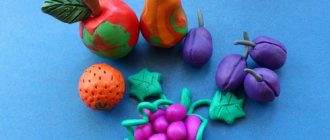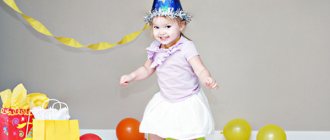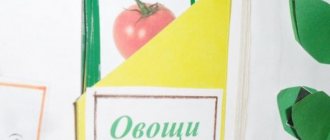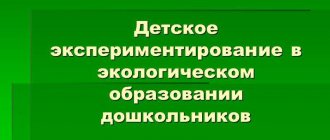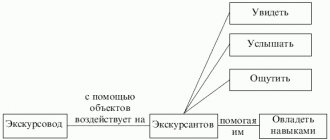Senior group. Senior preschool age. Children 5-6 years old
Summary of an open lesson on moral and patriotic education in the senior group “We are patriots of our Motherland” Purpose: To summarize and systematize children’s knowledge about Russia. Objectives: 1. Educational: to form a respectful attitude towards state symbols, to consolidate the names of large Russian cities and rivers, peoples inhabiting the Russian Federation; teach children to love their homeland, admire its beauty;...
Summary of an open lesson in the senior group “Customs and traditions of the Russian people”
MBDOU "Kolyvan kindergarten "Firefly"
Continuous educational activities on social and communicative development in the senior group Theme of the GCD:
“Customs and traditions of the Russian people
. Priority educational area: socio-communicative development. Integration with…
Activities, games and holidays with children 5-6 years old.
Showing publications 1-10 of 150654. All sections | Senior group
New
Photo
The best
Summary of a master class for children and parents on making a New Year's ball from threads (senior group) Purpose: 1) to attract parents to joint creativity with their children; 2) introduce parents and children to the technology of making a New Year’s ball from threads; 3) create a pre-New Year mood in the process of making toys. Progress of the master class: Stages Activities of the teacher Activities…
The use of SU-Jok therapy in the speech development of children of senior preschool age 1-slide Good afternoon, dear colleagues! Let me present to your attention a project on health-saving technology “Use of SU-Jok therapy in the speech development of children of senior preschool age.” "Magic Balls"
Long-term project, duration 1 year 2slide...
Open classes. Notes – Notes of an open lesson in the senior group “Travel on a ship”
Publication “Summary of an open lesson in the senior group “Journey to...” Integrated objectives: 1. Educational. Strengthen the ability to compose a whole from parts, identify signs of geometric shapes. Strengthen the skill of counting objects up to 7. Strengthen children's ability to create images of an animal using geometric shapes; strengthen the skill...
Summary of an open lesson in the senior group “My safety is in my hands” Summary of an open lesson in senior group “A” on the topic: “My safety is in my hands” Conducted by: teacher Baraova R.M. G.O. Nalchik Objectives: Educational: teach children to behave correctly at home when they are left alone without adults, consolidate knowledge of dangerous situations that can...
Summary of an open lesson “Winter sports” in the senior group Lesson in the senior group “Winter sports” using ICT Compiled by a teacher of the highest qualification category Natalya Rafailovna Ponomareva Goal: developing an idea of the importance of playing sports for health. Objectives: -To consolidate children’s knowledge about different types of...
Open lesson in the senior group on FEMP “Journey to the Land of Mathematics”
Summary of an open lesson in senior group No. 9 “Sun” (cognitive and research activities of F.E.M.P) “Journey to the country of Mathematics” Educator: T.G. Artamonova Purpose of the lesson: To create conditions for consolidating ideas about figures (triangle, rectangle, circle,...
Features of organizing work in classes in the senior group
Features of organizing work in classes in the senior group
In the older group, the duration of the lesson changes slightly compared to the average (from 20 to 25 minutes), but the volume and pace of work increase noticeably. Learning new things begins with repetition of material, which allows you to introduce new knowledge into the system of previously acquired ones. Repetition is often organized in the form of game exercises, problem solving (“Find Dunno’s mistake,” “Who is bigger?”) and takes from 1 to 5 minutes. Classes dedicated to consolidating knowledge also begin with game exercises. By stimulating the manifestation of ingenuity and ingenuity, these exercises allow children to focus their attention, activate their thinking, and create a good emotional mood. To consolidate knowledge, game exercises and didactic games are also carried out at the end of the lesson. In the senior group, combined exercises are widely used, allowing 2-3 tasks to be solved simultaneously. At the same time, work can be done on material from different sections of the program. In children aged 5 years, attention stability increases. However, they cannot perform monotonous work for a long time or maintain the same posture and need frequent changes of activities and motor relaxation. The teacher alternates work that requires voluntary attention with elements of the game. The number of similar exercises is limited to 3-4. Tasks related to performing movements are included. If there are no such tasks, then at the 12-14th minute a physical training minute is carried out. Whenever possible, its content is linked to the work in the classroom. The teacher tries to call as many children as possible to complete short tasks at his desk, flannelograph, on a typesetting canvas (add, remove an object, make pairs of objects, etc.). Visual, verbal and practical teaching methods and techniques in classes for the development of elementary mathematical concepts are mainly used in combination. Situations arise when existing knowledge is not enough to find the answer to the question posed, and a need arises to learn something new, to learn something new. For example, a teacher asks: “How can you find out how much longer the table is than its width?” The application technique known to children cannot be used. The teacher shows them a new way to compare lengths using a measuring stick. The incentive to search is suggestions to solve some kind of game or practical problem (pick a pair, make a rectangle equal to a given one, find out which objects are more, etc.). By organizing children’s independent work with handouts, the teacher also sets tasks for them (to check, learn, learn new things, etc.). Consolidation and clarification of knowledge and methods of action in a number of cases is carried out by offering children tasks, the content of which reflects situations that are close and understandable to them. So, they find out how long the laces of boots and low shoes are, select a watch strap that is suitable in width, etc. Children’s interest in solving such problems ensures active work and solid assimilation of knowledge. Mathematical concepts “equal”, “not equal”, “more - less”, “whole and part”, etc. are formed on the basis of comparison. Children 5 years old can already, under the guidance of a teacher, sequentially examine objects, identify and compare their homogeneous features. Based on comparison, children identify significant relationships, for example, relationships of equality and inequality, sequence, whole and part, etc., and make simple conclusions. The development of mental activity operations (analysis, synthesis, comparison, generalization) in the senior group is given great attention. Children perform all these operations based on clarity. The active inclusion of various analyzers in the work of children continues to be of great importance in the education of 5-year-old children. Consideration, analysis and comparison of objects when solving problems of the same type are carried out in a certain sequence. For example, children are taught to consistently analyze and describe a pattern made up of models of geometric shapes. Gradually they master the general method of solving problems of this category and consciously use it. In the older group, the types of visual aids are expanded and their nature is somewhat changed. Toys and things continue to be used as illustrative material. But now a big place is occupied by working with pictures, color and silhouette images of objects, and the drawings can be schematic. For example, the days of the week are conventionally indicated by multi-colored chips or numerical figures. This helps children establish ordinal relationships between the days of the week and remember their sequence. In working with children aged 5-6 years, the role of verbal teaching methods increases. The teacher’s instructions and explanations guide and plan the children’s activities. When giving instructions, he takes into account what the children know and can do, and only shows new methods of work. The teacher’s questions during the explanation stimulate children to show independence and intelligence, encouraging them to look for different ways to solve the same problem: “How else can you do it? Check? Say?" Children are taught to find different formulations to characterize the same mathematical connections and relationships. It is essential to practice new methods of action in speech. Therefore, while working with handouts, the teacher asks first one or the other child what, how and why he is doing. One child can do the task at the board at this time and explain his actions. Accompanying an action with speech allows children to comprehend it. After completing any task there is a survey. Children report on what and how they did and what happened as a result. Mistakes made by children are always corrected through actions with didactic material. As the child accumulates the ability to perform certain actions, you can first suggest what should be done and how (build a series of objects, group them, etc.), and then perform a practical action. This is how children are taught to plan the ways and order of completing a task. In the older group, they begin to use verbal games and game exercises, which are based on presentation actions: “Say the opposite!”, “Who can name it faster?”, “Which is longer (shorter)?” Increasing complexity and variation in work methods, changing aids and situations stimulate children to show independence and activate their thinking. To maintain interest in classes, the teacher constantly introduces elements of games (search, guessing) and competition, the opportunity to win: “Who can find (bring, etc.) faster.” When explaining to five-year-old children how to behave in class, they rely on their consciousness. The teacher constantly emphasizes that those who listen attentively to him and their comrades, work without distraction, and are always ready to answer questions, remember well and complete tasks correctly. Showing the dependence of the result of the work on how the children listened to and remembered the task teaches them to appreciate the teacher’s instructions and act exactly in accordance with them. The ability to manage their attention in 5-year-old children is just beginning to develop. Therefore, it is necessary to encourage them to be attentive. The teacher approves of those who try, work with concentration, keep up with their comrades and complete the task. When summing up the results of the lesson, they evaluate not only how the material was learned, but also the behavior of the children in the lesson. In the older group, children are often given tasks that, along with solving an educational task, train voluntary attention and memory, for example, game exercises “What has changed?”, “Silent”, etc. Much attention is paid to the development of self-control. The main means of developing self-control is the teacher’s assessment of the actions and results of children’s work. After listening to the child’s report on completing the task, he gives an assessment, helps to find the causes of errors and correct them. In some cases, children are asked to exchange work and check whether a friend has completed the task correctly. Self-control is fostered by presenting a sample after completing a task. Checking whether he did it as shown in the example, the child finds and corrects mistakes. Children are taught to fairly evaluate the results of their work and the work of their comrades. Controlling their own actions during work makes it difficult for five-year-old children, therefore, first they are taught to control each other’s work, for example, to monitor the actions of a friend working at the teacher’s desk (at the blackboard), to evaluate not only the result, but also the way the task is completed. Children are taught to listen carefully to a friend’s answer, not to repeat, but to supplement and clarify it. (“Have you said everything? Is it clear?”) They organize work in pairs, when one child completes the task and the other controls it. Evaluating the teacher and monitoring the actions of a friend allow children to further master the ability to control their own activities. In the older group, they continue to develop skills of organized behavior in class; children are taught to be restrained, to raise their hand only when they know how to answer a question, to wait patiently when called, to prepare their workplace, and to keep their manuals in order throughout the entire class. A large number of aids are used in mathematics classes, so it is important to provide for the order in which they are placed. When preparing for a lesson, it is advisable to arrange the manuals in such an order that those that will be needed first are at the top, and those at the bottom are the last. At first, they are placed on the table to the left of the child, and as work progresses, he puts the used aids to his right. Children now take small counting material from a common tray. In each specific case, the teacher determines what those on duty in the lesson should do and what each of the children should do. This also applies to organizing the workplace and cleaning up supplies after class.
Features of organizing mathematics classes in the senior group of kindergarten
Harm from “coaching” a preschooler according to the school curriculum
Yes, at first it will be very easy for the child to learn, because he already knows what his peers are going through. Therefore, he will gradually lose interest in classes. And after the stock of knowledge acquired in preschool age is exhausted, he will simply lag behind his classmates.
This opposite effect is explained by the fact that in elementary school what is needed is not previously acquired knowledge, but developed skills for educational activities. The question immediately arises about whether only the last year of preschool childhood is enough to prepare for school.
In order to simply “train” a child, this time may be enough, but in order to properly prepare for education, it is necessary to start classes in kindergarten in the senior group. Moreover, children’s education should take place in the form of a game, and not parody school lessons.
Lesson summary for children of senior preschool age
An educational lesson for older preschoolers aged 5-7 years with elements of practical activity. Topic: “The History of New Year’s Toys”
Description of material:
I bring to your attention a lesson summary with elements of practical activity for children of senior preschool age.
The material is intended for additional education teachers working in Early Development Centers, educators and for parents interested in the comprehensive development of preschoolers. Goal:
introduction to the culture of the New Year holiday, its traditions;
expanding and enriching children's knowledge about the history of New Year's toys. Objectives: Educational:
• introduce children to the history of the New Year holiday;
• the history of the appearance of Christmas tree decorations, Educational:
• to cultivate interest in the traditions of celebrating the New Year.
Developmental:
• to develop in children creative independence, aesthetic taste, creative abilities, imagination.
Equipment:
TV, laptop, beads and wire for making toys, bag for Christmas toys, Christmas tree.
Progress of the lesson
1. Organizational moment
We are in a great mood, and smiling is a common thing!
Let's wish each other well, It's time for us to start getting busy! 2. Setting the topic and goals of the lesson Teacher:
Girls and boys, you told me about how you are preparing to celebrate the New Year, what beautiful and elegant Christmas trees you have at home.
Teacher:
Look, someone’s bag is on the table?
(children’s answers - D. Moroz.) Teacher:
I wonder what’s in the bag?
Here are snowflakes with riddles. Maybe we can guess the riddles? Listen carefully. Suddenly the blizzards came with a terrible howl. Autumn ran away in fear, and she became the mistress. (Winter)
At least there are not cones, not needles, but hanging on the branches of a Christmas tree?
(Christmas decorations)
Teacher:
There's something else here.
Let's see what's there (takes out Christmas tree decorations.) Teacher:
What different and interesting toys
(examining toys)
A cap of snow on the mountain, All the trees are in silver, Ice sparkles on the pond, It's coming...
(New Year) Teacher:
You all love the holiday New Year?
(answers) Teacher:
It’s hard to find a person who doesn’t love the New Year.
The beautiful custom of decorating the Christmas tree arose many years ago. There was a belief that spirits live in trees, on which the future harvest and the fate of each person depend, so spirits must be respected with a variety of gifts. For a long time, Christmas trees were decorated with food - raisins, candies, nuts, cookies, pretzels, fruits, apples. Later they began to make more ornate jewelry. There were paper flowers and skillful crafts made from cotton wool and silver foil. And many, many years ago, by decree of Tsar Peter 1, it was ordered that January 1 be considered the beginning of the New Year, as in other countries. Everyone had to congratulate their relatives and friends on the holiday and decorate the Christmas tree. New Year's festivities were necessarily accompanied by games, songs, and dances. Teacher:
Get your hands ready.
Finger game
We had fun at the Christmas tree,
(Rhythmic clapping of hands)
And danced and frolicked
(Rhythmic fist bumps)
Afterwards, kind Santa Claus presented us with gifts.
(“Walk” with your middle and index fingers on the table)
.
He gave me huge bags, with delicious items in them: (rhythmic clapping of hands)
.
Candies in blue pieces of paper, (Fold the fingers on one or both hands, starting with the thumb)
.
Nuts next to them, a pear, an apple, one Golden tangerine. Teacher:
And at 12 o’clock at night, Peter I went out onto the square with a torch in his hands and launched the first rocket into the sky.
Thus began the fireworks in honor of the New Year holiday. Therefore, at exactly 12 o’clock at night, we say goodbye to the old year and welcome the New Year. Teacher:
How do they decorate the Christmas tree now?
(children's answers) Teacher:
So what kind of toys used to decorate the Christmas tree?
Let's look at the illustration: Glass, cardboard, cotton wool, porcelain. During the war years, captured Germans taught our craftsmen how to blow balls and beads. When it was wartime, Christmas tree decorations were made like this - soldiers, airplanes, various military vehicles. Military battles were even painted on balloons. When peacetime came, the toys immediately turned into fairy-tale characters, houses and Christmas trees, animals, vegetables and fruits and, of course, many colorful balls. But look - the Christmas tree of your fathers and mothers, grandfathers and grandmothers. Now the Christmas tree is most often decorated with multi-colored balls and various toys, glass and plastic, they are very easy to use and do not break. And there are unusual Christmas trees: made of balls, made of donuts, made of tinsel, and many other different ones, as much as your imagination can handle. Every year, different cities in our country put up Christmas trees on the main square of their city. They are large, all in lights and shimmer in different colors. And it's just fabulous! And of course, all the children dress up their green beauties at home. Christmas tree decoration made of beads Practical work
You will need: green, red and white beads, tinsel
(rain)
on a thin wire. Prepare 4 pieces of wire of the same size. 1. Twist 2 pieces together in the center to make 4 rays.
2. Add 2 pieces of wire to make 8 rays. String the beads onto the rays, alternating colors, leaving the ends of the wire pieces free. 3. Connect the ends of the wire, then twist them. 4. Shape the blank into a ball and decorate the Christmas tree.
5. Summary of the lesson
Guys, who remembers what toys they used to decorate the Christmas tree in the old days? And what do they decorate with now? What materials are modern Christmas tree decorations made from? Is it possible to make toys yourself? What a great fellow you are!
6. Reflection
"Snowflakes"
Attach a white snowflake to the board if the lesson went well, everything was clear and you are happy with your application
Attach a blue snowflake to the board if the lesson was difficult for you, uninteresting, or nothing was clear.
Instructions for the teacher for conducting classes
In order for classes in a group of older preschoolers to be effective and interesting for children, the teacher should follow some rules.
- Classes in kindergarten in the senior group involve the presentation of new, rather complex material in the form of a game. This develops visual memory and imaginative thinking well. In addition, the competitive element present in them spurs children to better assimilate knowledge.
- It is worth devoting sufficient time to repetition. But it is not necessary to do this during the lesson; you can do several repetition sessions at the beginning of the month.
- In order not to lose children's attention, you need to monitor the change in their activities. Various types of exercises, games, songs, riddles and dances should be interspersed.
And remember that adults should communicate with children only in a friendly manner. Under no circumstances should you use a commanding tone in class, much less scold a child.
